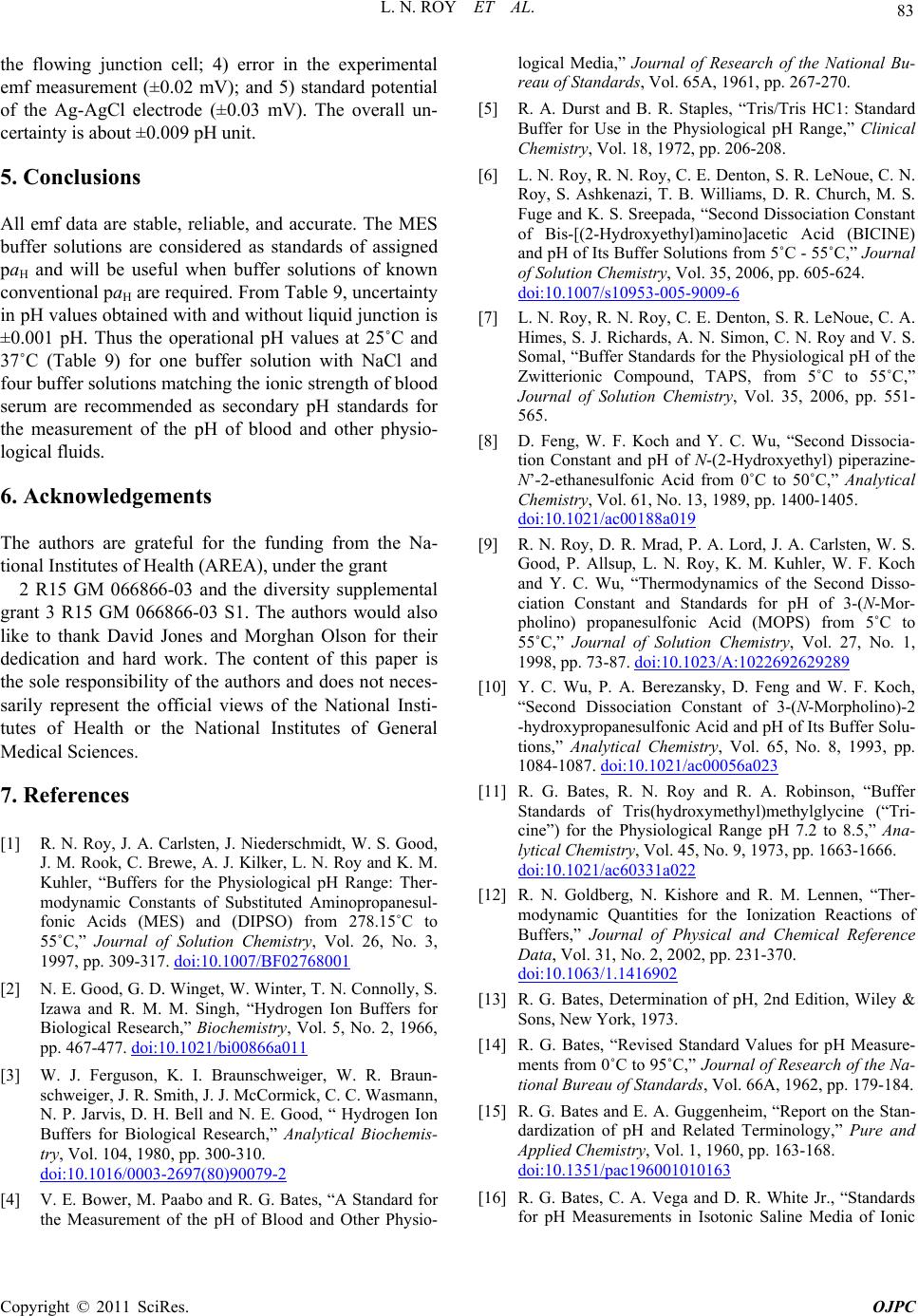
83
L. N. ROY ET AL.
the flowing junction cell; 4) error in the experimental
emf measurement (±0.02 mV); and 5) standard potential
of the Ag-AgCl electrode (±0.03 mV). The overall un-
certainty is about ±0.009 pH unit.
5. Conclusions
All emf data are stable, reliable, and accurate. The MES
buffer solutions are considered as standards of assigned
paH and will be useful when buffer solutions of known
conventional paH are required. From Table 9, uncertainty
in pH values obtained with and without liquid junction is
±0.001 pH. Thus the operational pH values at 25˚C and
37˚C (Table 9) for one buffer solution with NaCl and
four buffer solutions matching the ionic strength of blood
serum are recommended as secondary pH standards for
the measurement of the pH of blood and other physio-
logical fluids.
6. Acknowledgements
The authors are grateful for the funding from the Na-
tional Institutes of Health (AREA), under the grant
2 R15 GM 066866-03 and the diversity supplemental
grant 3 R15 GM 066866-03 S1. The authors would also
like to thank David Jones and Morghan Olson for their
dedication and hard work. The content of this paper is
the sole responsibility of the authors and does not neces-
sarily represent the official views of the National Insti-
tutes of Health or the National Institutes of General
Medical Sciences.
7. References
[1] R. N. Roy, J. A. Carlsten, J. Niederschmidt, W. S. Good,
J. M. Rook, C. Brewe, A. J. Kilker, L. N. Roy and K. M.
Kuhler, “Buffers for the Physiological pH Range: Ther-
modynamic Constants of Substituted Aminopropanesul-
fonic Acids (MES) and (DIPSO) from 278.15˚C to
55˚C,” Journal of Solution Chemistry, Vol. 26, No. 3,
1997, pp. 309-317. doi:10.1007/BF02768001
[2] N. E. Good, G. D. Winget, W. Winter, T. N. Connolly, S.
Izawa and R. M. M. Singh, “Hydrogen Ion Buffers for
Biological Research,” Biochemistry, Vol. 5, No. 2, 1966,
pp. 467-477. doi:10.1021/bi00866a011
[3] W. J. Ferguson, K. I. Braunschweiger, W. R. Braun-
schweiger, J. R. Smith, J. J. McCormick, C. C. Wasmann,
N. P. Jarvis, D. H. Bell and N. E. Good, “ Hydrogen Ion
Buffers for Biological Research,” Analytical Biochemis-
try, Vol. 104, 1980, pp. 300-310.
doi:10.1016/0003-2697(80)90079-2
[4] V. E. Bower, M. Paabo and R. G. Bates, “A Standard for
the Measurement of the pH of Blood and Other Physio-
logical Media,” Journal of Research of the National Bu-
reau of Standards, Vol. 65A, 1961, pp. 267-270.
[5] R. A. Durst and B. R. Staples, “Tris/Tris HC1: Standard
Buffer for Use in the Physiological pH Range,” Clinical
Chemistry, Vol. 18, 1972, pp. 206-208.
[6] L. N. Roy, R. N. Roy, C. E. Denton, S. R. LeNoue, C. N.
Roy, S. Ashkenazi, T. B. Williams, D. R. Church, M. S.
Fuge and K. S. Sreepada, “Second Dissociation Constant
of Bis-[(2-Hydroxyethyl)amino]acetic Acid (BICINE)
and pH of Its Buffer Solutions from 5˚C - 55˚C,” Journal
of Solution Chemistry, Vol. 35, 2006, pp. 605-624.
doi:10.1007/s10953-005-9009-6
[7] L. N. Roy, R. N. Roy, C. E. Denton, S. R. LeNoue, C. A.
Himes, S. J. Richards, A. N. Simon, C. N. Roy and V. S.
Somal, “Buffer Standards for the Physiological pH of the
Zwitterionic Compound, TAPS, from 5˚C to 55˚C,”
Journal of Solution Chemistry, Vol. 35, 2006, pp. 551-
565.
[8] D. Feng, W. F. Koch and Y. C. Wu, “Second Dissocia-
tion Constant and pH of N-(2-Hydroxyethyl) piperazine-
N’-2-ethanesulfonic Acid from 0˚C to 50˚C,” Analytical
Chemistry, Vol. 61, No. 13, 1989, pp. 1400-1405.
doi:10.1021/ac00188a019
[9] R. N. Roy, D. R. Mrad, P. A. Lord, J. A. Carlsten, W. S.
Good, P. Allsup, L. N. Roy, K. M. Kuhler, W. F. Koch
and Y. C. Wu, “Thermodynamics of the Second Disso-
ciation Constant and Standards for pH of 3-(N-Mor-
pholino) propanesulfonic Acid (MOPS) from 5˚C to
55˚C,” Journal of Solution Chemistry, Vol. 27, No. 1,
1998, pp. 73-87. doi:10.1023/A:1022692629289
[10] Y. C. Wu, P. A. Berezansky, D. Feng and W. F. Koch,
“Second Dissociation Constant of 3-(N-Morpholino)-2
-hydroxypropanesulfonic Acid and pH of Its Buffer Solu-
tions,” Analytical Chemistry, Vol. 65, No. 8, 1993, pp.
1084-1087. doi:10.1021/ac00056a023
[11] R. G. Bates, R. N. Roy and R. A. Robinson, “Buffer
Standards of Tris(hydroxymethyl)methylglycine (“Tri-
cine”) for the Physiological Range pH 7.2 to 8.5,” Ana-
lytical Chemistry, Vol. 45, No. 9, 1973, pp. 1663-1666.
doi:10.1021/ac60331a022
[12] R. N. Goldberg, N. Kishore and R. M. Lennen, “Ther-
modynamic Quantities for the Ionization Reactions of
Buffers,” Journal of Physical and Chemical Reference
Data, Vol. 31, No. 2, 2002, pp. 231-370.
doi:10.1063/1.1416902
[13] R. G. Bates, Determination of pH, 2nd Edition, Wiley &
Sons, New York, 1973.
[14] R. G. Bates, “Revised Standard Values for pH Measure-
ments from 0˚C to 95˚C,” Journal of Research of the Na-
tional Bureau of Standards, Vol. 66A, 1962, pp. 179-184.
[15] R. G. Bates and E. A. Guggenheim, “Report on the Stan-
dardization of pH and Related Terminology,” Pure and
Applied Chemistry, Vol. 1, 1960, pp. 163-168.
doi:10.1351/pac196001010163
[16] R. G. Bates, C. A. Vega and D. R. White Jr., “Standards
for pH Measurements in Isotonic Saline Media of Ionic
Copyright © 2011 SciRes. OJPC